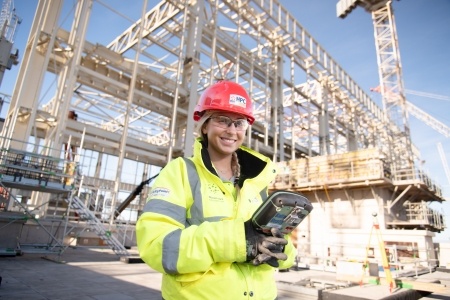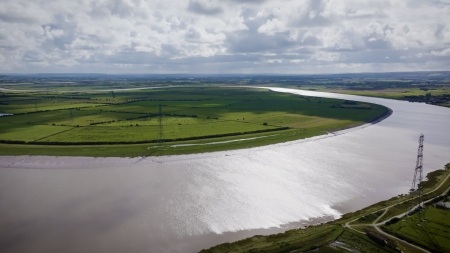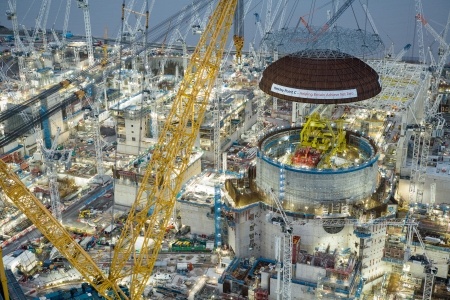Inspired by Some of History’s Most Influential Women
Over 70 local primary school pupils gathered together last week for the much-anticipated naming ceremony for Hinkley Point C’s three enormous tunnel boring machines.
The unique competition, launched by EDF Energy, gave 215 primary schools from across Somerset the opportunity to name the three 1,200 tonne tunnel boring machines that together will begin the construction of the new power stations’ water inlet and outfall tunnels.
After arriving safely at the construction site by sea and road, the trio of tunnelling machines will soon be removing 370,000 cubic metres of earth to enable 3.3 kilometres of tunnels to be built underneath the seabed. The tunnels will carry seawater to cool the two reactors, the first of which will see first operation in 2025.
Tunelling tradition decrees that these extraordinary machines can only start work once they have been officially named – and it must be a female name as the patron saint of miners is Saint Barbara.
The winning names were;
Mary Anning, a fossil finder based in Lyme Regus, chosen by St Peter’s First School in Williton.
Emmeline Pethick Lawrence, a locally based suffragette who fought alongside Emmeline Pankhurst for rights for women. Emmeline was born in Bristol before taking her fight to the city of London. This name was chosen by Stogursey Church of England Primary School.
Beatrice Shilling, also known as Tilly, a female engineer who worked to improve the mega machine that was the spitfire during the Second World War. Beatrice was named by Cannington Church of England Primary School.
During the process of selecting the winning names, a fourth name, Sarah Guppy, was selected to name the drilling kit which will be used to dig additional sections of the water outlet structure. Sarah was a design engineer ahead of her time rumoured to have played a lead role in the design of the Clifton Suspension Bridge.
At launch the machines will have their names and the respective winning school displayed proudly on their sides. In a lasting tribute, as the enormous sections will be unable to be retrieved on the tunnels completion, they will remain forever buried under the seabed as a time capsule dedicated to the winning school.
After a representative of each school revealed a plaque of the winning names, the pupils attending received a talk from one of the tunnelling team explaining the tunnelling process and full guided tour of the Hinkley Point C construction site.
West Somerset Councillor Sue Goss, said: 'A brilliant afternoon. The children really enjoyed it and I am sure they will remember it as a highlight of the year.'
Head Teacher of Stogursey Primary School, Rebecca Barnes, said: “The whole school is thrilled that Stogursey could have the honour of naming a machine. It has been a wonderful experience for the children to see first-hand what is happening so close to where they live whilst also being inspired by the role models of the past.
Local expertise was also used to overcome the logistical challenges of delivering such large components. Somerset based Osprey used its local knowledge to safely deliver the sections of the tunnel boring machines in one of the first major deliveries to the site by sea.
John O’Connor, Commercial Director for Osprey, said: “Safely completing this piece of work for HPC was a significant milestone that will pave the way for future marine deliveries. It has also been a privilege to support the engagement with the local children and I hope that it can inspire many more into construction and engineering.”
The event was organised by EDF Energy and would not have been possible without the input of HOST, Somerset Larder, FACE Balfour Beatty and Osprey.
Notes to editors
EDF Energy is leading the UK's nuclear renaissance with the construction of a new nuclear power station at Hinkley Point C. This will provide low carbon electricity to meet 7% of UK demand. The project is already making a positive impact on the local and national economy, British industry, as well as boosting skills and education. EDF Energy also invests in a range of low carbon technologies including renewables and battery storage. It is applying research and development expertise to improve the performance of existing generation and developing the potential of new technologies.
The Hinkley Point C Project is making excellent progress in constructing of the UK’s first new nuclear power station for a generation
During 2019, the Project will continue to maintain safe progress to schedule and cost to allow unit 1 to come online in 2025.
The key goals for 2019 include;
- The start of tunnelling work as part of the power station’s cooling water system. 3 tunnels will be bored under the Bristol Channel using tunnel boring machines which have already made their way to site.
- The completion of the major earthworks and excavations for Unit 2. We will have moved some 5.6 million m3 of earth.
- The milestone of J0 in June 2019. This will mark the start of units 1’s reactor building construction and will be a huge achievement for the project.
For more information
Andrew Cockcroft
External Communications Manager (South West)
(T) 01278 484098
(M) 07875113689
andrew.cockcroft@edf-energy.com
Related articles

New Skills, Better Jobs: Report Reveals the Positive Impact of Hinkley Point C

Hinkley Point C sets out plan to create Somerset saltmarsh
